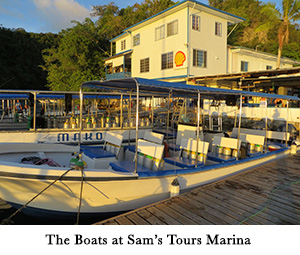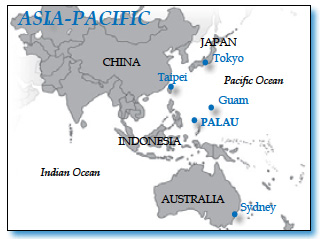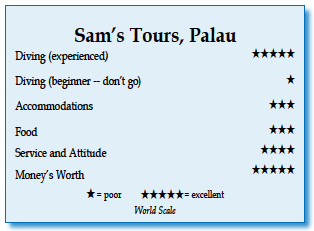Samís Tours, Palau, MicronesiaContents of this Issue: Samís Tours, Palau, Micronesia The Full Story on Palauís Changes Ecotourism Doesnít Affect Whale Sharks Bad Divemasters, Shark Scares . . . Class Action on Faulty Suunto Computers Continues Why These Readers Refuse to Give Up Their Spare Air Jennifer Anistonís New Husband Needs Better Dive Training The Shortcomings of Winged BCs A Wacky Instructorís Course Leads to Bent Diverís $15,000 Settlement Judge Rules That a Liability Waiver Doesnít Cover Snorkeling The Hazards of Diving Choppy Waters Itís Not Just the Fishermen who Are Destroying Reefs Editorial Office: Ben Davison Publisher and Editor Undercurrent 3020 Bridgeway, Suite 102 Sausalito, CA 94965 a less expensive alternative to a liveaboard from the January, 2016 issue of Undercurrent
Dear Fellow Diver: After three trips to Palau, my fourth felt like I was home. Palau . . . bucket list . . . dream dive . . . top five . . . world class . . . the superlatives become clichťs at some point. But for me, what has separated this spot from everywhere else I've dived is the balance it offers. You go to Raja for diversity. You go to Cocos for pelagics. You go to the Philippines for macro/muck. But with Palau, you get all of these without needing to stay on a liveaboard to guarantee kick-ass diving. And for less than $2,000 for seven nights. However, rapid change is afoot. You won't see it from a liveaboard, but you will if you stay in Koror. Starting last year, Chinese tourism took off big time, and Palau has been riding the whirlwind ever since. The culture clash is dividing the nation between those who have benefited (property owners, hotels, some merchants) and those who have not (renters squeezed by higher rents, Palauan workers -- the Chinese are bringing in their own laborers -- and traditional merchants not catering to the Chinese).
Downtown Koror hardly looks like Midtown Manhattan, but the increase in bright LED lights and fake neon signage dismays the locals. Less scrupulous restaurants have been busted for serving Napoleon wrasse and humphead parrotfish to cater to the Chinese. Others have been nailed for buying turtles and undersized crabs and lobsters. But it doesn't end there. I heard reports of rough treatment of Jellyfish Lake by the new tourists and tales of turtles being disturbed. I don't need to tell you what that means for the health of Palau's sea life if left unchecked. As I had before, I dived with Sam's Tours. Palau may be changing, but Sam's is not. However, that's a sword that cuts in two directions. I have nothing but compliments for the staff, especially the divemasters, who are both local and from overseas (Italian, American and Australia). Neil, a 30-something American, was my favorite divemaster in 2013 because he allowed me to cross Siaes Corner off my "un-dived" list and got me my first current dive at Ulong Channel after five current-less dives there. If you want to do something a little risky, the divemasters will make sure you know what you are getting into, but if you request a dive, they will try to make it happen. For me this year, that meant Shark City, which, along with Peleliu Cut and Express, seems to be permanently affixed to my "No dive for you" list, despite having made more than 60 dives in Palau. The depth (at least 110 feet) and its hit-and-miss nature, combined with its isolation from the rest of Palau's best dive spots, makes it infrequently visited. They finally offered it to me, and yet, I passed on it. You see, two days before, I had my most intense dive experience ever, at Blue Corner, hitting an immediate downdraft upon entry. Well before we neared the Corner, I was moving so fast, I stopped kicking. The currents were so strong, the red-tooth triggers that usually swarm the spot were all a few inches off the reef, flowing in a stream over the side. When I released my reef hook, I was blown off the reef. There was another downdraft waiting for my group and me when we hit open water; I dropped from 56 feet to 80 feet before I caught on and adjusted my buoyancy. Because of the currents, divers stay in groups, and most often, we came up together, to be met quickly by the boat. The boats can hold 16 people but are usually limited to 12, plus two divemasters. Sam's says no more than eight divers per divemaster, so if someone runs low on air, one divemaster will accompany him to the surface.
So we dived German Channel for the second day in a row. While water temperature at most sites was in the mid-80s, German Channel had serious thermoclines, with layers in the low 70s. The visibility was well off the usual 100 feet, and at 40 to 50 feet, it felt confining. I've had dives there where I've seen nothing of note and others there where I struck gold (descending from the surface, I once nearly landed on an exposed octopus). German Channel is famous for mantas, but I had only seen two mantas in six dives there. This year, I scored big, first snorkeling with a manta doing loops while feeding off plankton, then swimming down under with six at once. And then came the amazing spectacle of around a couple hundred frolicking melon-headed whales, coming together in a tight bunch, then separating and crisscrossing each other. Since Palau has banned long-line fishing, the pelagic populations have increased. While I didn't dive Blue Holes this year, the buzz was about the appearance of thresher sharks patrolling the opening of the cave. Dogtooth tuna numbers have gone up at Blue Corner. I watched redtooth triggers, anthias and trevally scatter in massive panic as a school of dogtooths, some as long as four feet, charged onto the reef behind, serving as a reminder that when hooked on the reef, the action isn't always in front of you; look behind occasionally. Drifting off the reef at New Drop Off, I peered into the deep, where I could make out around two dozen sharks swimming in a mass. On one dive through Ulong Channel, I witnessed a Chinese group pass by. One female diver freaked out and was dragged back to the group by their Chinese instructor . . . right past a guy standing on the reef while holding onto it with his hand. Nobody did anything about that. The damage inflicted by typhoons Bopha (2012) and Haiyan (2013) still looms large over Palau's eastern reefs. Nobody dives Ngerchong now unless that's the last option available. The reefs were destroyed and will probably not recover fully in our lifetimes. A recent survey of eastern reefs found that the coral cover was down by 60 percent. But Palau's crown jewels managed to escape relatively unscathed from the twin terrors. Sam's is as friendly and helpful today as it was when I first dived with them in 2009, though I sense they are trying to do more with less. The facilities have remained largely unchanged, except for a new cement rinse tank added for wetsuits. There's no place to spread your gear to dry in the open air other than the small concrete retaining wall, so there's a constant fight for space. Your alternative is to stow your stuff in the storage area, but it may not dry by the morning when you carry it out to the boat. Nick Martorano's photography shop is no longer in business at Sam's, and I miss being able to buy a video of one of my dives. While I shoot decent-quality stuff, on my best day I couldn't match what Nick could produce. But in this GoPro, selfie-stick age where newbies think they can be Howard Hall for just a few hundred bucks -- that is, until they review their shaky, too-blue footage -- it's difficult to make a living running a photography shop.
The DW Motel is fine for what it is (the beds have been upgraded) but after so many days, living a minimalist existence with no TV and no free Wi-Fi takes its toll. I had hoped to spend a few days at Caroline's Resort, employing its secret weapon -- in the past, anyone who stayed there had free access to the facilities of the beautiful, upscale Palau Pacific Resort, without having to pay through the nose to stay there. Now, to access the PPR, one has to pay a $50 per-day fee, so I selected PPR, which would be about the same price. I caught a break, getting upgraded to an ocean-view room next to the pool. The rooms are very nice, even equipped with futuristic toilets with proximity sensors that light up the bowl when you approach (yeah, I don't see the need either). The PPR once had a nice man-made beach and lagoon with a great sunset view, but they built water bungalows on one side of the beach, ruining the feel. The PPR, while luxurious, is very pricey, but then again, so is Palau in general. While you can always grab a burger or pizza, proper dinners with offerings like lobster sashimi or crab will cost you. Twice, I came within striking distance of $200 for two, but one doesn't often get seafood that fresh and the meals were wonderful, though I passed on the $200 mangrove crabs. Breakfast across the street from the DW at the Rock Islands Grill ran $30 for two with tip. To get there, United remains the best, cheapest option from the U.S. ($2,200, though special fare sales drop it to around $1,600). After arriving in Guam from Honolulu, I faced a 45-minute scheduled window to make the Koror connection, but our late-arriving plane missed it, leading to an unplanned 24-hour Guam layover. I was told that the connection is blown about 40 percent of the time. Unless you want to fly on days when the flight goes through Yap (and departs later from Guam) or on the days when it departs later from Guam (and you get in late to Koror), there's a real chance you may spend the night on Guam. Other options: Fly nonstop to Taipei, Tokyo or other destinations that have nonstop flights to Palau. Finally, I must say, even with the changes in Palau, I'll be back to dive with Sam's, expecting few changes in the operation, but that's OK with me since it will be just like coming home. If you want to see my trip on video, have a look at https://www.youtube.com/watch?v=YUy_LL-Dd88 -- D.S. Our undercover diver's bio: D.S. says, "Prior to 2008, I saw myself as a tech worker who just hit the ski slopes every few years and that's it. Then I got bit by the diving bug. Now I can't see past the ocean. Since then, I've made more than 200 dives in the cold and rugged waters of Northern California, while shuttling off to various South Pacific and Indian Ocean venues, where the waters are much more comfortable."
|

I want to get all the stories! Tell me how I can become an Undercurrent Online Member and get online access to all the articles of Undercurrent as well as thousands of first hand reports on dive operations world-wide
| Home | Online Members Area | My Account |
Login
|
Join
|
| Travel Index |
Dive Resort & Liveaboard Reviews
|
Featured Reports
|
Recent
Issues
|
Back Issues
|
|
Dive Gear
Index
|
Health/Safety Index
|
Environment & Misc.
Index
|
Seasonal Planner
|
Blogs
|
Free Articles
|
Book Picks
|
News
|
|
Special Offers
|
RSS
|
FAQ
|
About Us
|
Contact Us
|
Links
|
3020 Bridgeway, Ste 102, Sausalito, Ca 94965
All rights reserved.

 Hotels are being block-booked by Chinese tour operators
half a year or more in advance. In April, I looked
for a room at the
Sea Passion Resort in
November, and there
was nothing. Other
good hotels were similarly
block-booked.
Fortunately, the DW
Motel, where I stayed
in 2013, was available.
It was okay
-- it had the hardest
bed I'd ever slept
on, but it was cheap,
and in less than 20
minutes, I could walk to downtown restaurants like Sushi Bar
Mito and Mog Mog (you haven't lived
until you've had lobster sashimi). The
DW caters to the Japanese and frugal
divers like me who want to save their
money for diving but can't afford a
liveaboard for two people. You can
wash your clothes ($4 for the washer
and dryer), and while there is a restaurant
across the street, there is
even a kitchen where you can refrigerate
food and make your own meals.
Hotels are being block-booked by Chinese tour operators
half a year or more in advance. In April, I looked
for a room at the
Sea Passion Resort in
November, and there
was nothing. Other
good hotels were similarly
block-booked.
Fortunately, the DW
Motel, where I stayed
in 2013, was available.
It was okay
-- it had the hardest
bed I'd ever slept
on, but it was cheap,
and in less than 20
minutes, I could walk to downtown restaurants like Sushi Bar
Mito and Mog Mog (you haven't lived
until you've had lobster sashimi). The
DW caters to the Japanese and frugal
divers like me who want to save their
money for diving but can't afford a
liveaboard for two people. You can
wash your clothes ($4 for the washer
and dryer), and while there is a restaurant
across the street, there is
even a kitchen where you can refrigerate
food and make your own meals. The morning we were to dive
Shark City, Neil took me aside and
laid it all out: the day before,
currents had been worse than Blue
Corner. While I was still game, I had a problem dragging the rest of the dive group with me into conditions
like that. The dive would be over and done at depth in 20 minutes. Next time,
Shark City. Next time.
The morning we were to dive
Shark City, Neil took me aside and
laid it all out: the day before,
currents had been worse than Blue
Corner. While I was still game, I had a problem dragging the rest of the dive group with me into conditions
like that. The dive would be over and done at depth in 20 minutes. Next time,
Shark City. Next time. Sam's uses covered dual-outboard speedboats (oh, oh, no heads) that, after
motoring through the picturesque Rock Islands, reach most sites in about 50
minutes (wrecks are closer). After the first tank, they serve lunch -- sandwiches,
a bento box or teriyaki chicken, which you select from a menu the day
before. Tea and juice drinks are onboard. The boat returns after two dives,
but goes out again for a third. There is little demand for night dives. One
doesn't dive with the same divers or the same group every day (Sam's has a
dozen boats), so I didn't get much of a chance to make friends, as I might on
a liveaboard. One 40-something American diver stands out, however. At New Drop
Off, to celebrate her 200th dive, she tossed her bikini aside, donned her gear,
and jumped in buck-naked. Weird.
Sam's uses covered dual-outboard speedboats (oh, oh, no heads) that, after
motoring through the picturesque Rock Islands, reach most sites in about 50
minutes (wrecks are closer). After the first tank, they serve lunch -- sandwiches,
a bento box or teriyaki chicken, which you select from a menu the day
before. Tea and juice drinks are onboard. The boat returns after two dives,
but goes out again for a third. There is little demand for night dives. One
doesn't dive with the same divers or the same group every day (Sam's has a
dozen boats), so I didn't get much of a chance to make friends, as I might on
a liveaboard. One 40-something American diver stands out, however. At New Drop
Off, to celebrate her 200th dive, she tossed her bikini aside, donned her gear,
and jumped in buck-naked. Weird. Divers Compass: The DW Motel was $65 per night . . . Sam's
Tours is $145 for two tanks, $40 for a third dive, but they
offered reduced-rate package deals; nitrox is extra . . .
Add $50 for a 10-day permit to scuba or snorkel, $50 more
to include Jellyfish Lake; Peleliu State is another $30 for
a 10-day permit . . . If you don't want to travel with your
gear, you can rent 3-mm wetsuits, BCs, wristband computers,
etc. (I had trouble with the depth gauges on two of my rental
regulators and had to go back twice before I got one that
wasn't malfunctioning); reef hooks are also available . . . Sam's van makes
hotel pick-ups about 8:30 a.m. (earlier on the first day) and boat pickups
from the Palau Pacific Resort . . . After the dives, I hung out at Sam's
seaside bar for a coffee or a beer and snacks, before heading back to the
hotel; for tourists, poking around town is fun, there are plenty of sites to
see and Sam's can arrange tours . . . Hotels arrange airport transfers, about
$20 a person . . . Currency is American dollars and ATMs are available . . .
Website -
Divers Compass: The DW Motel was $65 per night . . . Sam's
Tours is $145 for two tanks, $40 for a third dive, but they
offered reduced-rate package deals; nitrox is extra . . .
Add $50 for a 10-day permit to scuba or snorkel, $50 more
to include Jellyfish Lake; Peleliu State is another $30 for
a 10-day permit . . . If you don't want to travel with your
gear, you can rent 3-mm wetsuits, BCs, wristband computers,
etc. (I had trouble with the depth gauges on two of my rental
regulators and had to go back twice before I got one that
wasn't malfunctioning); reef hooks are also available . . . Sam's van makes
hotel pick-ups about 8:30 a.m. (earlier on the first day) and boat pickups
from the Palau Pacific Resort . . . After the dives, I hung out at Sam's
seaside bar for a coffee or a beer and snacks, before heading back to the
hotel; for tourists, poking around town is fun, there are plenty of sites to
see and Sam's can arrange tours . . . Hotels arrange airport transfers, about
$20 a person . . . Currency is American dollars and ATMs are available . . .
Website - 